BUS 364: Managing a Diverse Workforce - Literature Review and Analysis
VerifiedAdded on 2022/08/18
|8
|2162
|16
Report
AI Summary
This report, prepared for BUS 364, investigates the impact of diversity and inclusion, focusing on age and racial diversity, in the workforce. It begins with an introduction outlining the significance of these topics and their importance in today's diverse work environments, emphasizing the authors' personal connection as immigrants and members of minority groups. The literature review summarizes findings from various studies, highlighting both positive and negative effects of age and racial diversity, such as increased innovation versus potential conflicts, and increased employee morale versus potential misunderstandings. The analysis section compares different researchers' viewpoints, offering the author's assessment of the existing material, and identifies gaps in the research. The report concludes by summarizing key findings, emphasizing the relationship between diversity, inclusion, and productivity, and the need for further research to quantify the impact of diversity on workforce outcomes. The report uses APA 7th edition citations and references scientific, peer-reviewed journal articles.
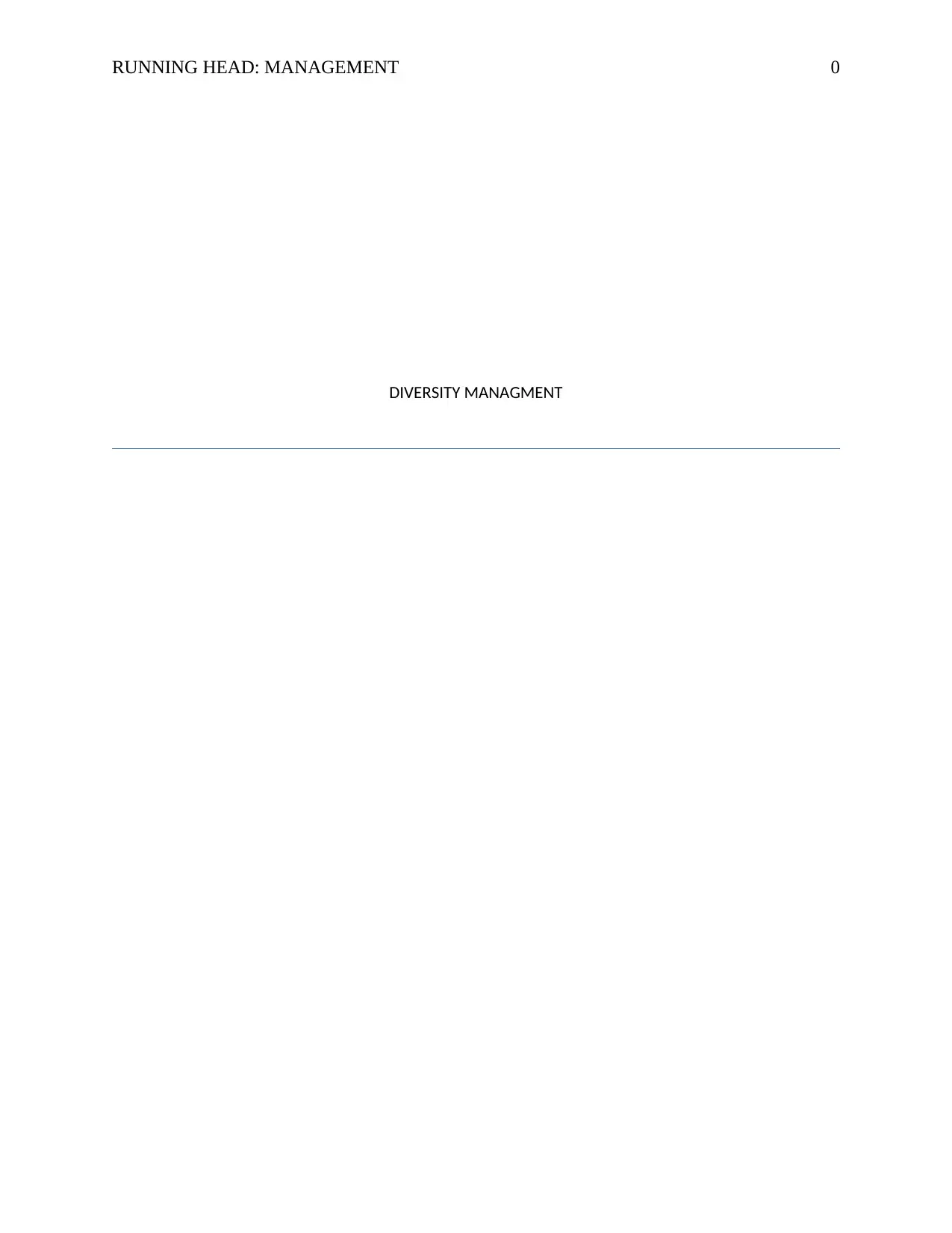
RUNNING HEAD: MANAGEMENT 0
DIVERSITY MANAGMENT
DIVERSITY MANAGMENT
Paraphrase This Document
Need a fresh take? Get an instant paraphrase of this document with our AI Paraphraser
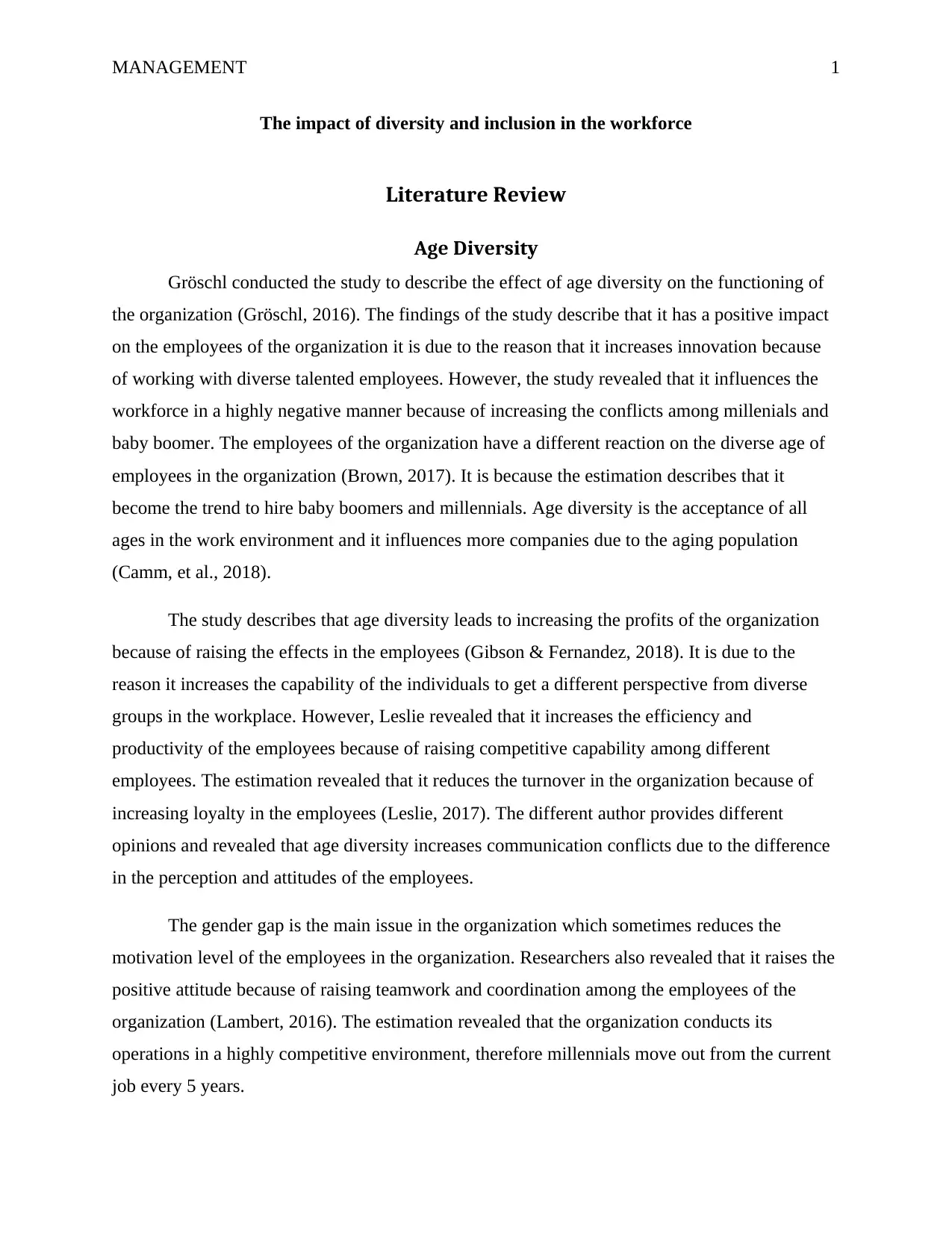
MANAGEMENT 1
The impact of diversity and inclusion in the workforce
Literature Review
Age Diversity
Gröschl conducted the study to describe the effect of age diversity on the functioning of
the organization (Gröschl, 2016). The findings of the study describe that it has a positive impact
on the employees of the organization it is due to the reason that it increases innovation because
of working with diverse talented employees. However, the study revealed that it influences the
workforce in a highly negative manner because of increasing the conflicts among millenials and
baby boomer. The employees of the organization have a different reaction on the diverse age of
employees in the organization (Brown, 2017). It is because the estimation describes that it
become the trend to hire baby boomers and millennials. Age diversity is the acceptance of all
ages in the work environment and it influences more companies due to the aging population
(Camm, et al., 2018).
The study describes that age diversity leads to increasing the profits of the organization
because of raising the effects in the employees (Gibson & Fernandez, 2018). It is due to the
reason it increases the capability of the individuals to get a different perspective from diverse
groups in the workplace. However, Leslie revealed that it increases the efficiency and
productivity of the employees because of raising competitive capability among different
employees. The estimation revealed that it reduces the turnover in the organization because of
increasing loyalty in the employees (Leslie, 2017). The different author provides different
opinions and revealed that age diversity increases communication conflicts due to the difference
in the perception and attitudes of the employees.
The gender gap is the main issue in the organization which sometimes reduces the
motivation level of the employees in the organization. Researchers also revealed that it raises the
positive attitude because of raising teamwork and coordination among the employees of the
organization (Lambert, 2016). The estimation revealed that the organization conducts its
operations in a highly competitive environment, therefore millennials move out from the current
job every 5 years.
The impact of diversity and inclusion in the workforce
Literature Review
Age Diversity
Gröschl conducted the study to describe the effect of age diversity on the functioning of
the organization (Gröschl, 2016). The findings of the study describe that it has a positive impact
on the employees of the organization it is due to the reason that it increases innovation because
of working with diverse talented employees. However, the study revealed that it influences the
workforce in a highly negative manner because of increasing the conflicts among millenials and
baby boomer. The employees of the organization have a different reaction on the diverse age of
employees in the organization (Brown, 2017). It is because the estimation describes that it
become the trend to hire baby boomers and millennials. Age diversity is the acceptance of all
ages in the work environment and it influences more companies due to the aging population
(Camm, et al., 2018).
The study describes that age diversity leads to increasing the profits of the organization
because of raising the effects in the employees (Gibson & Fernandez, 2018). It is due to the
reason it increases the capability of the individuals to get a different perspective from diverse
groups in the workplace. However, Leslie revealed that it increases the efficiency and
productivity of the employees because of raising competitive capability among different
employees. The estimation revealed that it reduces the turnover in the organization because of
increasing loyalty in the employees (Leslie, 2017). The different author provides different
opinions and revealed that age diversity increases communication conflicts due to the difference
in the perception and attitudes of the employees.
The gender gap is the main issue in the organization which sometimes reduces the
motivation level of the employees in the organization. Researchers also revealed that it raises the
positive attitude because of raising teamwork and coordination among the employees of the
organization (Lambert, 2016). The estimation revealed that the organization conducts its
operations in a highly competitive environment, therefore millennials move out from the current
job every 5 years.
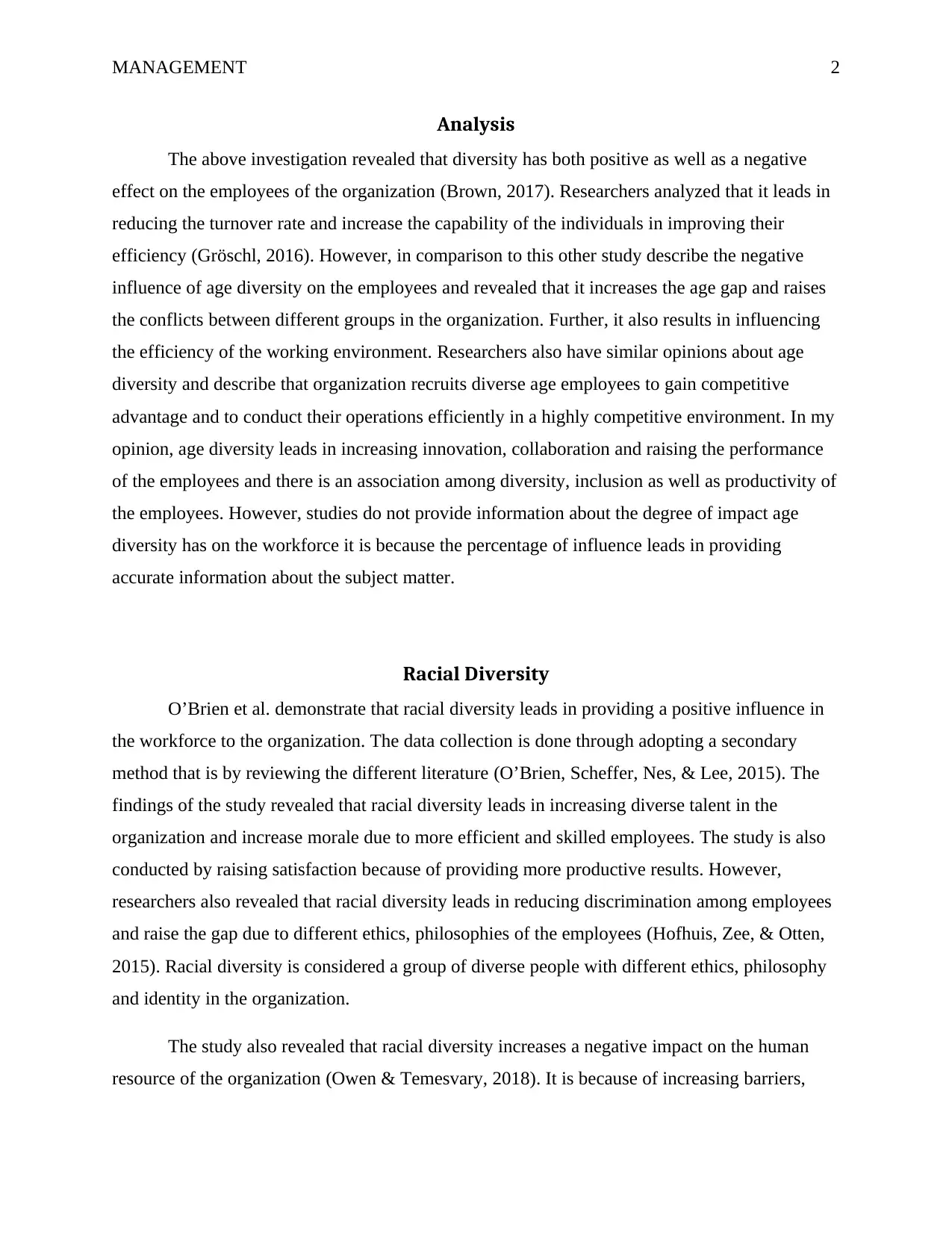
MANAGEMENT 2
Analysis
The above investigation revealed that diversity has both positive as well as a negative
effect on the employees of the organization (Brown, 2017). Researchers analyzed that it leads in
reducing the turnover rate and increase the capability of the individuals in improving their
efficiency (Gröschl, 2016). However, in comparison to this other study describe the negative
influence of age diversity on the employees and revealed that it increases the age gap and raises
the conflicts between different groups in the organization. Further, it also results in influencing
the efficiency of the working environment. Researchers also have similar opinions about age
diversity and describe that organization recruits diverse age employees to gain competitive
advantage and to conduct their operations efficiently in a highly competitive environment. In my
opinion, age diversity leads in increasing innovation, collaboration and raising the performance
of the employees and there is an association among diversity, inclusion as well as productivity of
the employees. However, studies do not provide information about the degree of impact age
diversity has on the workforce it is because the percentage of influence leads in providing
accurate information about the subject matter.
Racial Diversity
O’Brien et al. demonstrate that racial diversity leads in providing a positive influence in
the workforce to the organization. The data collection is done through adopting a secondary
method that is by reviewing the different literature (O’Brien, Scheffer, Nes, & Lee, 2015). The
findings of the study revealed that racial diversity leads in increasing diverse talent in the
organization and increase morale due to more efficient and skilled employees. The study is also
conducted by raising satisfaction because of providing more productive results. However,
researchers also revealed that racial diversity leads in reducing discrimination among employees
and raise the gap due to different ethics, philosophies of the employees (Hofhuis, Zee, & Otten,
2015). Racial diversity is considered a group of diverse people with different ethics, philosophy
and identity in the organization.
The study also revealed that racial diversity increases a negative impact on the human
resource of the organization (Owen & Temesvary, 2018). It is because of increasing barriers,
Analysis
The above investigation revealed that diversity has both positive as well as a negative
effect on the employees of the organization (Brown, 2017). Researchers analyzed that it leads in
reducing the turnover rate and increase the capability of the individuals in improving their
efficiency (Gröschl, 2016). However, in comparison to this other study describe the negative
influence of age diversity on the employees and revealed that it increases the age gap and raises
the conflicts between different groups in the organization. Further, it also results in influencing
the efficiency of the working environment. Researchers also have similar opinions about age
diversity and describe that organization recruits diverse age employees to gain competitive
advantage and to conduct their operations efficiently in a highly competitive environment. In my
opinion, age diversity leads in increasing innovation, collaboration and raising the performance
of the employees and there is an association among diversity, inclusion as well as productivity of
the employees. However, studies do not provide information about the degree of impact age
diversity has on the workforce it is because the percentage of influence leads in providing
accurate information about the subject matter.
Racial Diversity
O’Brien et al. demonstrate that racial diversity leads in providing a positive influence in
the workforce to the organization. The data collection is done through adopting a secondary
method that is by reviewing the different literature (O’Brien, Scheffer, Nes, & Lee, 2015). The
findings of the study revealed that racial diversity leads in increasing diverse talent in the
organization and increase morale due to more efficient and skilled employees. The study is also
conducted by raising satisfaction because of providing more productive results. However,
researchers also revealed that racial diversity leads in reducing discrimination among employees
and raise the gap due to different ethics, philosophies of the employees (Hofhuis, Zee, & Otten,
2015). Racial diversity is considered a group of diverse people with different ethics, philosophy
and identity in the organization.
The study also revealed that racial diversity increases a negative impact on the human
resource of the organization (Owen & Temesvary, 2018). It is because of increasing barriers,
⊘ This is a preview!⊘
Do you want full access?
Subscribe today to unlock all pages.

Trusted by 1+ million students worldwide
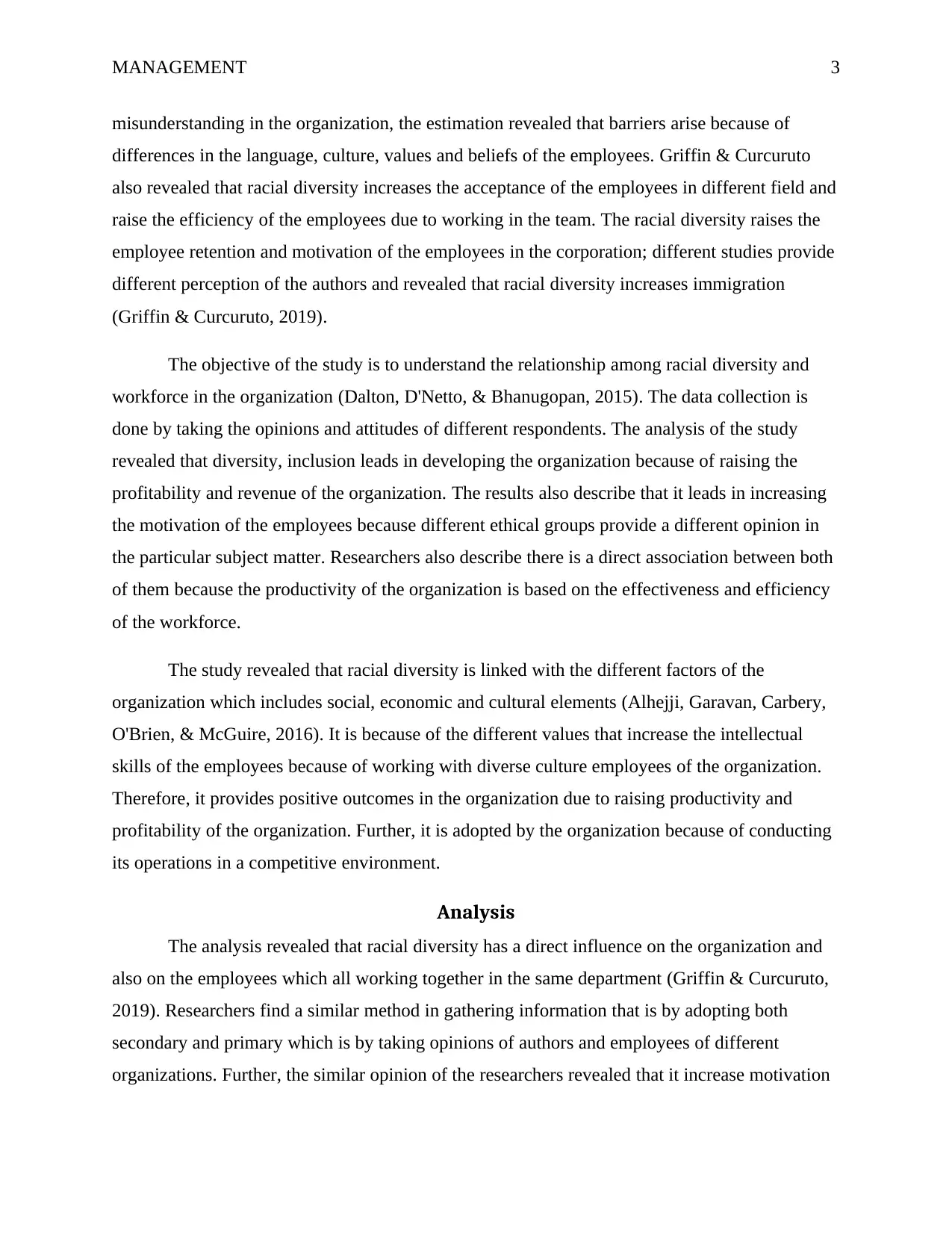
MANAGEMENT 3
misunderstanding in the organization, the estimation revealed that barriers arise because of
differences in the language, culture, values and beliefs of the employees. Griffin & Curcuruto
also revealed that racial diversity increases the acceptance of the employees in different field and
raise the efficiency of the employees due to working in the team. The racial diversity raises the
employee retention and motivation of the employees in the corporation; different studies provide
different perception of the authors and revealed that racial diversity increases immigration
(Griffin & Curcuruto, 2019).
The objective of the study is to understand the relationship among racial diversity and
workforce in the organization (Dalton, D'Netto, & Bhanugopan, 2015). The data collection is
done by taking the opinions and attitudes of different respondents. The analysis of the study
revealed that diversity, inclusion leads in developing the organization because of raising the
profitability and revenue of the organization. The results also describe that it leads in increasing
the motivation of the employees because different ethical groups provide a different opinion in
the particular subject matter. Researchers also describe there is a direct association between both
of them because the productivity of the organization is based on the effectiveness and efficiency
of the workforce.
The study revealed that racial diversity is linked with the different factors of the
organization which includes social, economic and cultural elements (Alhejji, Garavan, Carbery,
O'Brien, & McGuire, 2016). It is because of the different values that increase the intellectual
skills of the employees because of working with diverse culture employees of the organization.
Therefore, it provides positive outcomes in the organization due to raising productivity and
profitability of the organization. Further, it is adopted by the organization because of conducting
its operations in a competitive environment.
Analysis
The analysis revealed that racial diversity has a direct influence on the organization and
also on the employees which all working together in the same department (Griffin & Curcuruto,
2019). Researchers find a similar method in gathering information that is by adopting both
secondary and primary which is by taking opinions of authors and employees of different
organizations. Further, the similar opinion of the researchers revealed that it increase motivation
misunderstanding in the organization, the estimation revealed that barriers arise because of
differences in the language, culture, values and beliefs of the employees. Griffin & Curcuruto
also revealed that racial diversity increases the acceptance of the employees in different field and
raise the efficiency of the employees due to working in the team. The racial diversity raises the
employee retention and motivation of the employees in the corporation; different studies provide
different perception of the authors and revealed that racial diversity increases immigration
(Griffin & Curcuruto, 2019).
The objective of the study is to understand the relationship among racial diversity and
workforce in the organization (Dalton, D'Netto, & Bhanugopan, 2015). The data collection is
done by taking the opinions and attitudes of different respondents. The analysis of the study
revealed that diversity, inclusion leads in developing the organization because of raising the
profitability and revenue of the organization. The results also describe that it leads in increasing
the motivation of the employees because different ethical groups provide a different opinion in
the particular subject matter. Researchers also describe there is a direct association between both
of them because the productivity of the organization is based on the effectiveness and efficiency
of the workforce.
The study revealed that racial diversity is linked with the different factors of the
organization which includes social, economic and cultural elements (Alhejji, Garavan, Carbery,
O'Brien, & McGuire, 2016). It is because of the different values that increase the intellectual
skills of the employees because of working with diverse culture employees of the organization.
Therefore, it provides positive outcomes in the organization due to raising productivity and
profitability of the organization. Further, it is adopted by the organization because of conducting
its operations in a competitive environment.
Analysis
The analysis revealed that racial diversity has a direct influence on the organization and
also on the employees which all working together in the same department (Griffin & Curcuruto,
2019). Researchers find a similar method in gathering information that is by adopting both
secondary and primary which is by taking opinions of authors and employees of different
organizations. Further, the similar opinion of the researchers revealed that it increase motivation
Paraphrase This Document
Need a fresh take? Get an instant paraphrase of this document with our AI Paraphraser
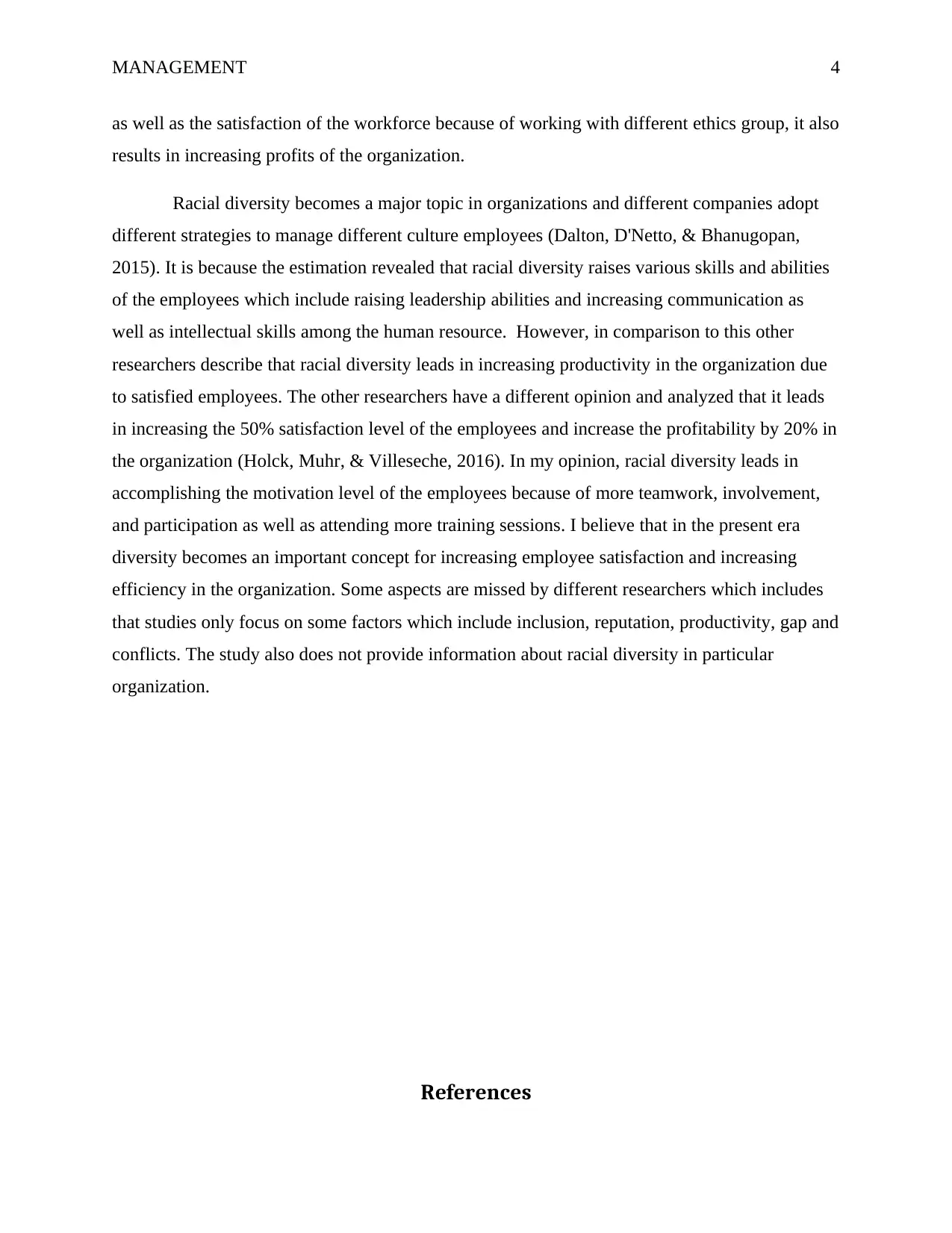
MANAGEMENT 4
as well as the satisfaction of the workforce because of working with different ethics group, it also
results in increasing profits of the organization.
Racial diversity becomes a major topic in organizations and different companies adopt
different strategies to manage different culture employees (Dalton, D'Netto, & Bhanugopan,
2015). It is because the estimation revealed that racial diversity raises various skills and abilities
of the employees which include raising leadership abilities and increasing communication as
well as intellectual skills among the human resource. However, in comparison to this other
researchers describe that racial diversity leads in increasing productivity in the organization due
to satisfied employees. The other researchers have a different opinion and analyzed that it leads
in increasing the 50% satisfaction level of the employees and increase the profitability by 20% in
the organization (Holck, Muhr, & Villeseche, 2016). In my opinion, racial diversity leads in
accomplishing the motivation level of the employees because of more teamwork, involvement,
and participation as well as attending more training sessions. I believe that in the present era
diversity becomes an important concept for increasing employee satisfaction and increasing
efficiency in the organization. Some aspects are missed by different researchers which includes
that studies only focus on some factors which include inclusion, reputation, productivity, gap and
conflicts. The study also does not provide information about racial diversity in particular
organization.
References
as well as the satisfaction of the workforce because of working with different ethics group, it also
results in increasing profits of the organization.
Racial diversity becomes a major topic in organizations and different companies adopt
different strategies to manage different culture employees (Dalton, D'Netto, & Bhanugopan,
2015). It is because the estimation revealed that racial diversity raises various skills and abilities
of the employees which include raising leadership abilities and increasing communication as
well as intellectual skills among the human resource. However, in comparison to this other
researchers describe that racial diversity leads in increasing productivity in the organization due
to satisfied employees. The other researchers have a different opinion and analyzed that it leads
in increasing the 50% satisfaction level of the employees and increase the profitability by 20% in
the organization (Holck, Muhr, & Villeseche, 2016). In my opinion, racial diversity leads in
accomplishing the motivation level of the employees because of more teamwork, involvement,
and participation as well as attending more training sessions. I believe that in the present era
diversity becomes an important concept for increasing employee satisfaction and increasing
efficiency in the organization. Some aspects are missed by different researchers which includes
that studies only focus on some factors which include inclusion, reputation, productivity, gap and
conflicts. The study also does not provide information about racial diversity in particular
organization.
References
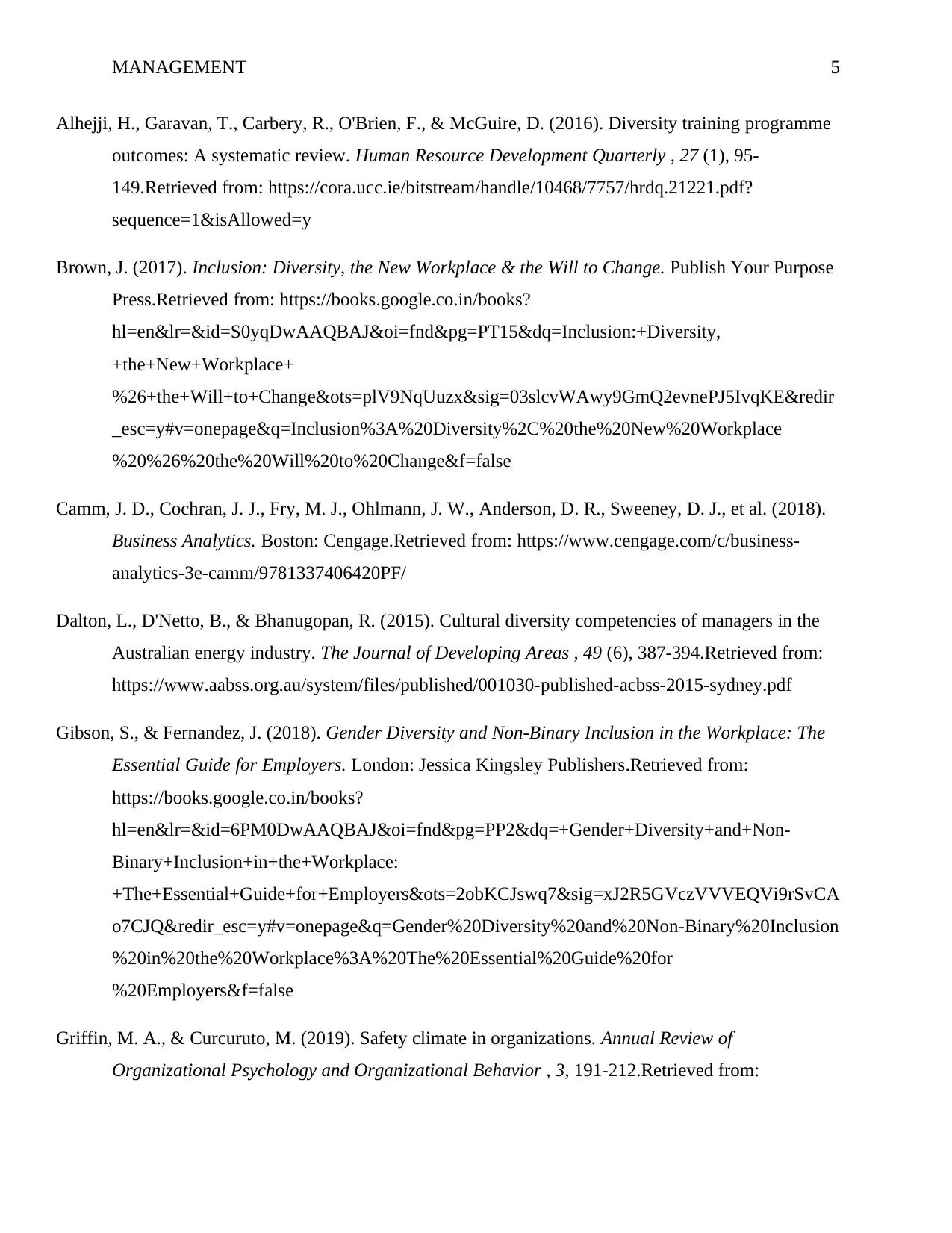
MANAGEMENT 5
Alhejji, H., Garavan, T., Carbery, R., O'Brien, F., & McGuire, D. (2016). Diversity training programme
outcomes: A systematic review. Human Resource Development Quarterly , 27 (1), 95-
149.Retrieved from: https://cora.ucc.ie/bitstream/handle/10468/7757/hrdq.21221.pdf?
sequence=1&isAllowed=y
Brown, J. (2017). Inclusion: Diversity, the New Workplace & the Will to Change. Publish Your Purpose
Press.Retrieved from: https://books.google.co.in/books?
hl=en&lr=&id=S0yqDwAAQBAJ&oi=fnd&pg=PT15&dq=Inclusion:+Diversity,
+the+New+Workplace+
%26+the+Will+to+Change&ots=plV9NqUuzx&sig=03slcvWAwy9GmQ2evnePJ5IvqKE&redir
_esc=y#v=onepage&q=Inclusion%3A%20Diversity%2C%20the%20New%20Workplace
%20%26%20the%20Will%20to%20Change&f=false
Camm, J. D., Cochran, J. J., Fry, M. J., Ohlmann, J. W., Anderson, D. R., Sweeney, D. J., et al. (2018).
Business Analytics. Boston: Cengage.Retrieved from: https://www.cengage.com/c/business-
analytics-3e-camm/9781337406420PF/
Dalton, L., D'Netto, B., & Bhanugopan, R. (2015). Cultural diversity competencies of managers in the
Australian energy industry. The Journal of Developing Areas , 49 (6), 387-394.Retrieved from:
https://www.aabss.org.au/system/files/published/001030-published-acbss-2015-sydney.pdf
Gibson, S., & Fernandez, J. (2018). Gender Diversity and Non-Binary Inclusion in the Workplace: The
Essential Guide for Employers. London: Jessica Kingsley Publishers.Retrieved from:
https://books.google.co.in/books?
hl=en&lr=&id=6PM0DwAAQBAJ&oi=fnd&pg=PP2&dq=+Gender+Diversity+and+Non-
Binary+Inclusion+in+the+Workplace:
+The+Essential+Guide+for+Employers&ots=2obKCJswq7&sig=xJ2R5GVczVVVEQVi9rSvCA
o7CJQ&redir_esc=y#v=onepage&q=Gender%20Diversity%20and%20Non-Binary%20Inclusion
%20in%20the%20Workplace%3A%20The%20Essential%20Guide%20for
%20Employers&f=false
Griffin, M. A., & Curcuruto, M. (2019). Safety climate in organizations. Annual Review of
Organizational Psychology and Organizational Behavior , 3, 191-212.Retrieved from:
Alhejji, H., Garavan, T., Carbery, R., O'Brien, F., & McGuire, D. (2016). Diversity training programme
outcomes: A systematic review. Human Resource Development Quarterly , 27 (1), 95-
149.Retrieved from: https://cora.ucc.ie/bitstream/handle/10468/7757/hrdq.21221.pdf?
sequence=1&isAllowed=y
Brown, J. (2017). Inclusion: Diversity, the New Workplace & the Will to Change. Publish Your Purpose
Press.Retrieved from: https://books.google.co.in/books?
hl=en&lr=&id=S0yqDwAAQBAJ&oi=fnd&pg=PT15&dq=Inclusion:+Diversity,
+the+New+Workplace+
%26+the+Will+to+Change&ots=plV9NqUuzx&sig=03slcvWAwy9GmQ2evnePJ5IvqKE&redir
_esc=y#v=onepage&q=Inclusion%3A%20Diversity%2C%20the%20New%20Workplace
%20%26%20the%20Will%20to%20Change&f=false
Camm, J. D., Cochran, J. J., Fry, M. J., Ohlmann, J. W., Anderson, D. R., Sweeney, D. J., et al. (2018).
Business Analytics. Boston: Cengage.Retrieved from: https://www.cengage.com/c/business-
analytics-3e-camm/9781337406420PF/
Dalton, L., D'Netto, B., & Bhanugopan, R. (2015). Cultural diversity competencies of managers in the
Australian energy industry. The Journal of Developing Areas , 49 (6), 387-394.Retrieved from:
https://www.aabss.org.au/system/files/published/001030-published-acbss-2015-sydney.pdf
Gibson, S., & Fernandez, J. (2018). Gender Diversity and Non-Binary Inclusion in the Workplace: The
Essential Guide for Employers. London: Jessica Kingsley Publishers.Retrieved from:
https://books.google.co.in/books?
hl=en&lr=&id=6PM0DwAAQBAJ&oi=fnd&pg=PP2&dq=+Gender+Diversity+and+Non-
Binary+Inclusion+in+the+Workplace:
+The+Essential+Guide+for+Employers&ots=2obKCJswq7&sig=xJ2R5GVczVVVEQVi9rSvCA
o7CJQ&redir_esc=y#v=onepage&q=Gender%20Diversity%20and%20Non-Binary%20Inclusion
%20in%20the%20Workplace%3A%20The%20Essential%20Guide%20for
%20Employers&f=false
Griffin, M. A., & Curcuruto, M. (2019). Safety climate in organizations. Annual Review of
Organizational Psychology and Organizational Behavior , 3, 191-212.Retrieved from:
⊘ This is a preview!⊘
Do you want full access?
Subscribe today to unlock all pages.

Trusted by 1+ million students worldwide
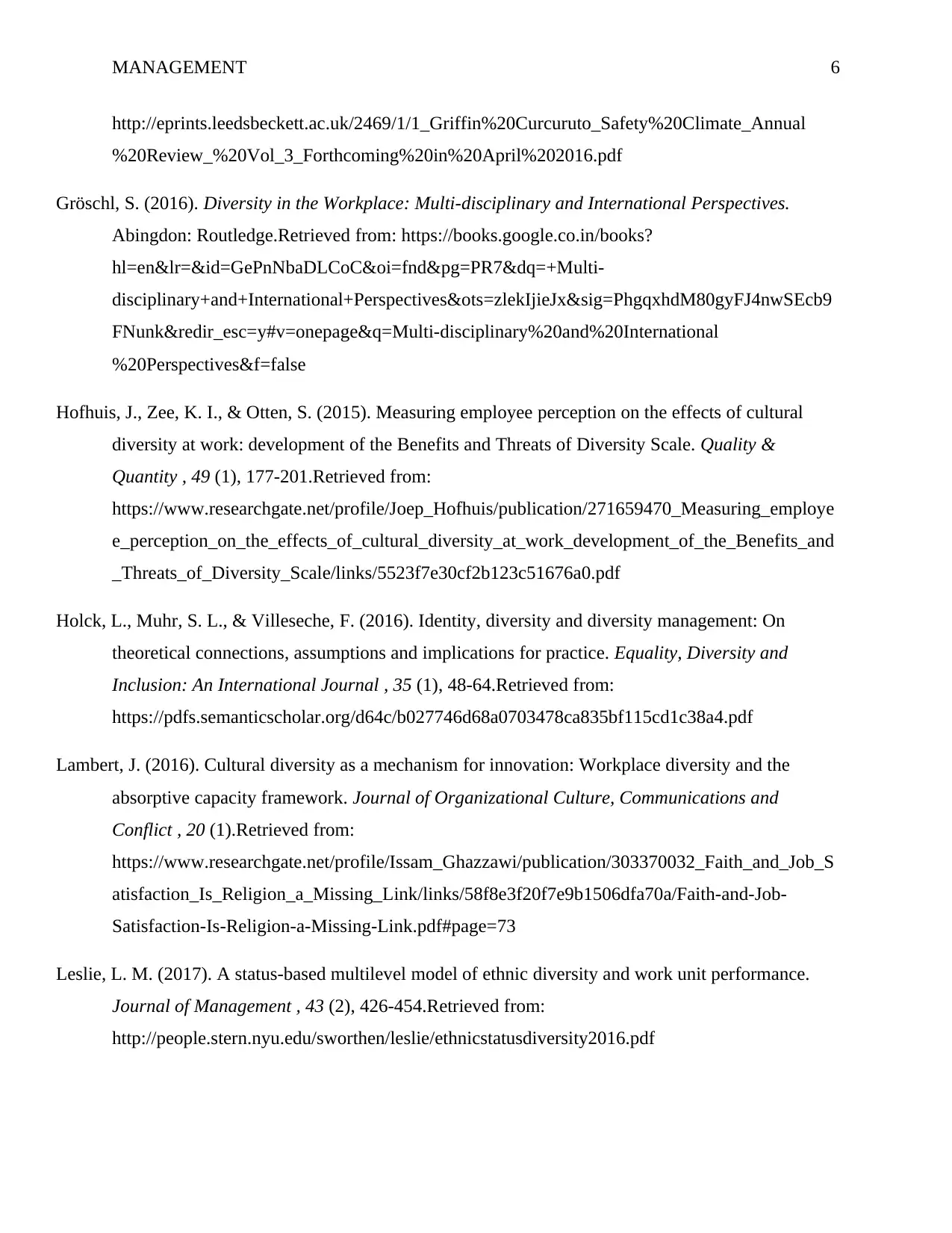
MANAGEMENT 6
http://eprints.leedsbeckett.ac.uk/2469/1/1_Griffin%20Curcuruto_Safety%20Climate_Annual
%20Review_%20Vol_3_Forthcoming%20in%20April%202016.pdf
Gröschl, S. (2016). Diversity in the Workplace: Multi-disciplinary and International Perspectives.
Abingdon: Routledge.Retrieved from: https://books.google.co.in/books?
hl=en&lr=&id=GePnNbaDLCoC&oi=fnd&pg=PR7&dq=+Multi-
disciplinary+and+International+Perspectives&ots=zlekIjieJx&sig=PhgqxhdM80gyFJ4nwSEcb9
FNunk&redir_esc=y#v=onepage&q=Multi-disciplinary%20and%20International
%20Perspectives&f=false
Hofhuis, J., Zee, K. I., & Otten, S. (2015). Measuring employee perception on the effects of cultural
diversity at work: development of the Benefits and Threats of Diversity Scale. Quality &
Quantity , 49 (1), 177-201.Retrieved from:
https://www.researchgate.net/profile/Joep_Hofhuis/publication/271659470_Measuring_employe
e_perception_on_the_effects_of_cultural_diversity_at_work_development_of_the_Benefits_and
_Threats_of_Diversity_Scale/links/5523f7e30cf2b123c51676a0.pdf
Holck, L., Muhr, S. L., & Villeseche, F. (2016). Identity, diversity and diversity management: On
theoretical connections, assumptions and implications for practice. Equality, Diversity and
Inclusion: An International Journal , 35 (1), 48-64.Retrieved from:
https://pdfs.semanticscholar.org/d64c/b027746d68a0703478ca835bf115cd1c38a4.pdf
Lambert, J. (2016). Cultural diversity as a mechanism for innovation: Workplace diversity and the
absorptive capacity framework. Journal of Organizational Culture, Communications and
Conflict , 20 (1).Retrieved from:
https://www.researchgate.net/profile/Issam_Ghazzawi/publication/303370032_Faith_and_Job_S
atisfaction_Is_Religion_a_Missing_Link/links/58f8e3f20f7e9b1506dfa70a/Faith-and-Job-
Satisfaction-Is-Religion-a-Missing-Link.pdf#page=73
Leslie, L. M. (2017). A status-based multilevel model of ethnic diversity and work unit performance.
Journal of Management , 43 (2), 426-454.Retrieved from:
http://people.stern.nyu.edu/sworthen/leslie/ethnicstatusdiversity2016.pdf
http://eprints.leedsbeckett.ac.uk/2469/1/1_Griffin%20Curcuruto_Safety%20Climate_Annual
%20Review_%20Vol_3_Forthcoming%20in%20April%202016.pdf
Gröschl, S. (2016). Diversity in the Workplace: Multi-disciplinary and International Perspectives.
Abingdon: Routledge.Retrieved from: https://books.google.co.in/books?
hl=en&lr=&id=GePnNbaDLCoC&oi=fnd&pg=PR7&dq=+Multi-
disciplinary+and+International+Perspectives&ots=zlekIjieJx&sig=PhgqxhdM80gyFJ4nwSEcb9
FNunk&redir_esc=y#v=onepage&q=Multi-disciplinary%20and%20International
%20Perspectives&f=false
Hofhuis, J., Zee, K. I., & Otten, S. (2015). Measuring employee perception on the effects of cultural
diversity at work: development of the Benefits and Threats of Diversity Scale. Quality &
Quantity , 49 (1), 177-201.Retrieved from:
https://www.researchgate.net/profile/Joep_Hofhuis/publication/271659470_Measuring_employe
e_perception_on_the_effects_of_cultural_diversity_at_work_development_of_the_Benefits_and
_Threats_of_Diversity_Scale/links/5523f7e30cf2b123c51676a0.pdf
Holck, L., Muhr, S. L., & Villeseche, F. (2016). Identity, diversity and diversity management: On
theoretical connections, assumptions and implications for practice. Equality, Diversity and
Inclusion: An International Journal , 35 (1), 48-64.Retrieved from:
https://pdfs.semanticscholar.org/d64c/b027746d68a0703478ca835bf115cd1c38a4.pdf
Lambert, J. (2016). Cultural diversity as a mechanism for innovation: Workplace diversity and the
absorptive capacity framework. Journal of Organizational Culture, Communications and
Conflict , 20 (1).Retrieved from:
https://www.researchgate.net/profile/Issam_Ghazzawi/publication/303370032_Faith_and_Job_S
atisfaction_Is_Religion_a_Missing_Link/links/58f8e3f20f7e9b1506dfa70a/Faith-and-Job-
Satisfaction-Is-Religion-a-Missing-Link.pdf#page=73
Leslie, L. M. (2017). A status-based multilevel model of ethnic diversity and work unit performance.
Journal of Management , 43 (2), 426-454.Retrieved from:
http://people.stern.nyu.edu/sworthen/leslie/ethnicstatusdiversity2016.pdf
Paraphrase This Document
Need a fresh take? Get an instant paraphrase of this document with our AI Paraphraser
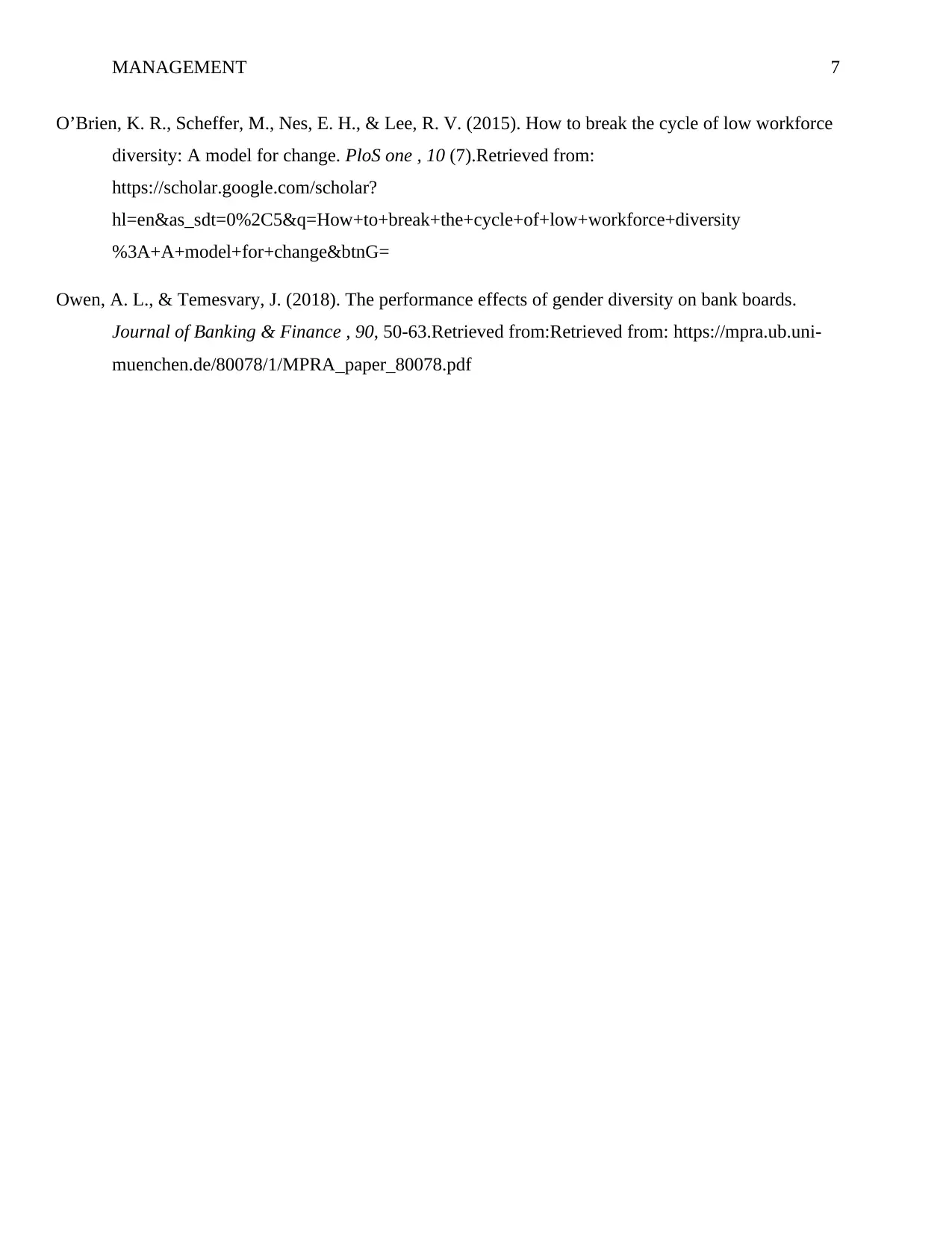
MANAGEMENT 7
O’Brien, K. R., Scheffer, M., Nes, E. H., & Lee, R. V. (2015). How to break the cycle of low workforce
diversity: A model for change. PloS one , 10 (7).Retrieved from:
https://scholar.google.com/scholar?
hl=en&as_sdt=0%2C5&q=How+to+break+the+cycle+of+low+workforce+diversity
%3A+A+model+for+change&btnG=
Owen, A. L., & Temesvary, J. (2018). The performance effects of gender diversity on bank boards.
Journal of Banking & Finance , 90, 50-63.Retrieved from:Retrieved from: https://mpra.ub.uni-
muenchen.de/80078/1/MPRA_paper_80078.pdf
O’Brien, K. R., Scheffer, M., Nes, E. H., & Lee, R. V. (2015). How to break the cycle of low workforce
diversity: A model for change. PloS one , 10 (7).Retrieved from:
https://scholar.google.com/scholar?
hl=en&as_sdt=0%2C5&q=How+to+break+the+cycle+of+low+workforce+diversity
%3A+A+model+for+change&btnG=
Owen, A. L., & Temesvary, J. (2018). The performance effects of gender diversity on bank boards.
Journal of Banking & Finance , 90, 50-63.Retrieved from:Retrieved from: https://mpra.ub.uni-
muenchen.de/80078/1/MPRA_paper_80078.pdf
1 out of 8
Related Documents
Your All-in-One AI-Powered Toolkit for Academic Success.
+13062052269
info@desklib.com
Available 24*7 on WhatsApp / Email
![[object Object]](/_next/static/media/star-bottom.7253800d.svg)
Unlock your academic potential
Copyright © 2020–2025 A2Z Services. All Rights Reserved. Developed and managed by ZUCOL.





